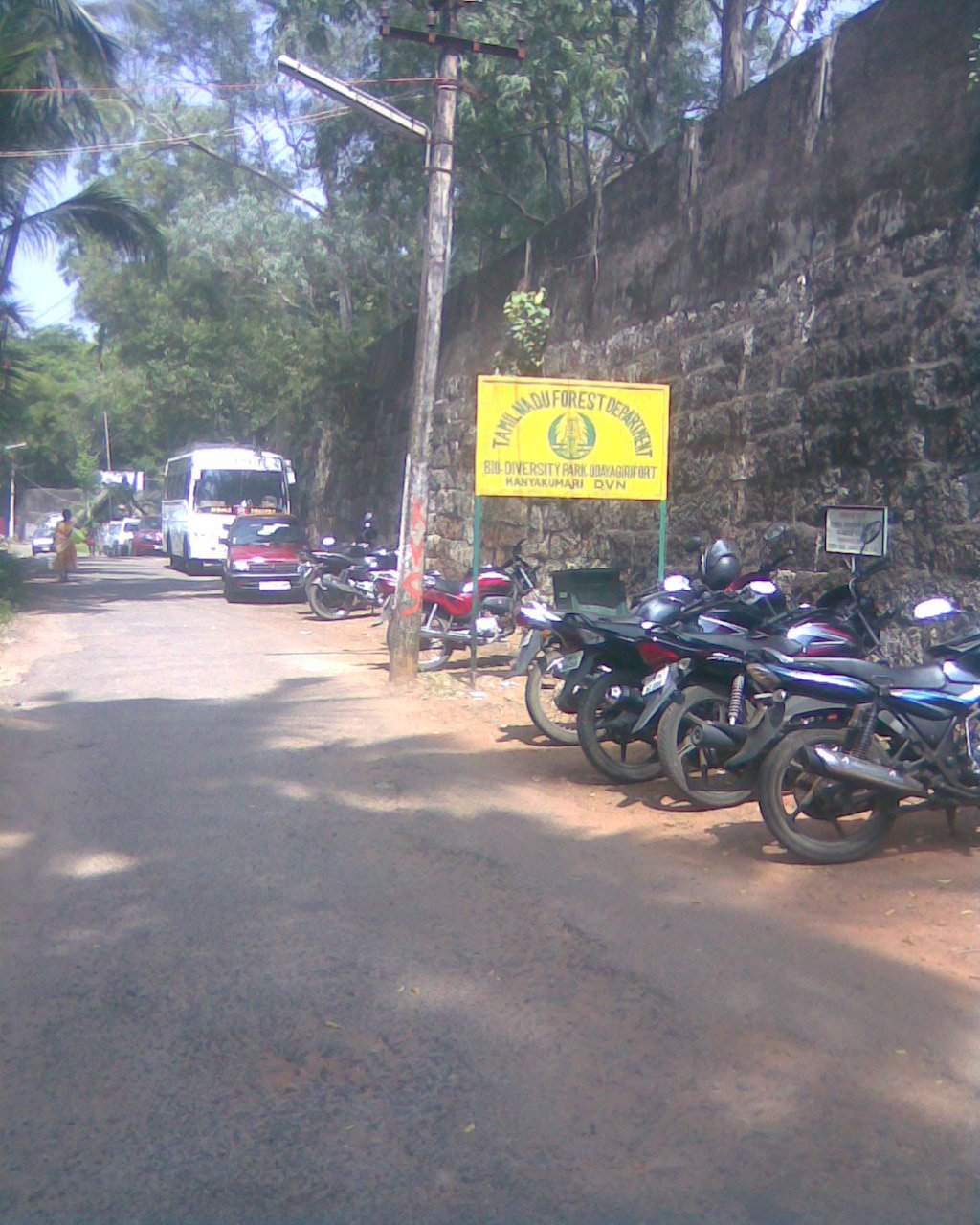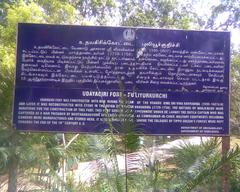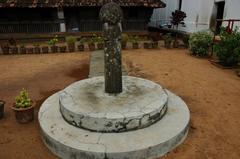
Visiting Udayagiri Fort: History, Tickets, and Travel Tips
Date: 22/07/2024
Introduction
Udayagiri Fort, an architectural and historical marvel nestled near Nagercoil in Tamil Nadu, India, stands as a testament to the region’s rich past. Constructed in the 17th century by the Venad kings and later fortified by Marthanda Varma, the ruler of the Travancore Kingdom in the 18th century, this fort has witnessed significant historical events and cultural exchanges. Its strategic location amidst the Western Ghats not only provided military advantages but also contributed to its historical significance (source).
The fort’s architecture is a blend of indigenous and European styles, reflecting the influence of various foreign powers, including the Dutch and the British. Notably, Udayagiri Fort played a pivotal role in the Battle of Colachel in 1741, where Marthanda Varma’s forces secured a decisive victory against the Dutch East India Company (source). Today, the fort remains a popular destination for tourists and history enthusiasts, offering insights into its storied past through well-preserved structures and informative displays.
This comprehensive guide aims to provide visitors with all the necessary information to plan their trip to Udayagiri Fort, including its history, visiting hours, ticket information, and practical travel tips. Whether you are a history buff, a nature lover, or simply looking for a unique travel experience, Udayagiri Fort promises an enriching and memorable visit.
Table of Contents
- Introduction
- Early Origins and Construction
- Role in the Travancore Kingdom
- European Influence and Technological Advancements
- The Battle of Colachel
- British Occupation and Later Years
- Architectural Features and Layout
- Preservation and Restoration Efforts
- Cultural Significance and Tourism
- Visitor Tips and Practical Information
- FAQ
- Conclusion
Early Origins and Construction
Udayagiri Fort, originally constructed by the Venad kings, served as a military stronghold in the 17th century. The fort’s strategic location amidst the Western Ghats made it a critical site for defense and administration.
Role in the Travancore Kingdom
The fort gained prominence during the reign of Marthanda Varma, the ruler of the Travancore Kingdom, in the 18th century. Marthanda Varma expanded and fortified Udayagiri Fort to bolster its defenses against invasions. The fort’s robust granite walls and bastions exemplify the architectural prowess of the period.
European Influence and Technological Advancements
In the 18th century, Udayagiri Fort saw significant European influence, particularly from the Dutch and the British. The fort’s design incorporated European military engineering techniques, including moats, drawbridges, and fortified gates, enhancing its defensive capabilities.
The Battle of Colachel
The fort is notably associated with the Battle of Colachel in 1741, a significant conflict between the Travancore Kingdom and the Dutch East India Company. The victory of Marthanda Varma’s forces marked a turning point in the region’s history, establishing Travancore as a dominant power. Udayagiri Fort played a pivotal role in the defense strategy during this period.
British Occupation and Later Years
In the early 19th century, Udayagiri Fort came under British control following the Anglo-Mysore Wars and subsequent treaties. The British utilized the fort as a military outpost and administrative center, continuing its strategic importance.
Architectural Features and Layout
Udayagiri Fort is renowned for its unique architectural features, reflecting a blend of indigenous and European styles. Key structures within the fort include the main entrance gate, bastions, watchtowers, a small palace, barracks, and a chapel, highlighting its multifaceted role.
Preservation and Restoration Efforts
Recognizing its historical and cultural significance, efforts have been made to preserve and restore Udayagiri Fort. The Archaeological Survey of India (ASI) has undertaken initiatives to maintain the fort’s structural integrity, including wall conservation, restoration of key structures, and development of visitor facilities.
Cultural Significance and Tourism
Udayagiri Fort holds immense cultural significance, serving as a testament to the region’s rich history and architectural heritage. The fort attracts numerous tourists and history enthusiasts, offering a glimpse into the past through its well-preserved structures and informative displays. Its scenic location amidst lush greenery and the Western Ghats adds to its allure.
Visitor Tips and Practical Information
For those planning to visit Udayagiri Fort, here are some practical tips:
- Visiting Hours - The fort is typically open from 9:00 AM to 5:00 PM daily. Check the latest timings before your visit.
- Tickets - Entry fees may apply. Verify ticket prices in advance.
- Accessibility - Comfortable walking shoes and sun protection are recommended due to the fort’s expansive grounds.
- Nearby Attractions - Explore nearby sites like Padmanabhapuram Palace and the Thiruvalluvar Statue for a comprehensive cultural experience.
- Guided Tours - Opt for guided tours to gain in-depth knowledge of the fort’s history and features.
- Photography - The fort offers numerous photographic spots, especially against the backdrop of the Western Ghats.
FAQ
What are the visiting hours for Udayagiri Fort?
The fort is typically open from 9:00 AM to 5:00 PM daily. It’s best to check the latest timings before your visit.
Is there a guided tour available at Udayagiri Fort?
Yes, guided tours are available and recommended for a more comprehensive exploration of the fort’s history and features.
For more detailed information on Udayagiri Fort and its historical significance, refer to resources provided by the Archaeological Survey of India.
Conclusion
Udayagiri Fort stands as a remarkable symbol of Nagercoil’s historical and cultural heritage. From its strategic construction in the 17th century to its pivotal role in the Travancore Kingdom’s defense strategies, the fort encapsulates a rich tapestry of historical events and architectural brilliance (source). The fort’s blend of indigenous and European architectural elements, coupled with its lush surroundings and biodiversity, makes it a multifaceted attraction for tourists, historians, and nature enthusiasts alike.
Preservation efforts by the Archaeological Survey of India (ASI) ensure that the fort remains a valuable educational and tourist site, allowing future generations to appreciate its historical significance and cultural contributions (source). Visitors are encouraged to explore nearby attractions, engage in guided tours for a deeper understanding, and respect the local customs and environment during their visit.
In summary, Udayagiri Fort is not just a historical monument but a living testament to the region’s rich past and cultural exchanges. By visiting, one can gain a profound appreciation of the area’s history, architecture, and natural beauty. For those planning a trip, this guide provides all the essential information to ensure a safe, enjoyable, and insightful experience at Udayagiri Fort.
References
- Exploring Udayagiri Fort - History, Visiting Hours, and Travel Tips, 2024, ASI
- Visiting Udayagiri Fort - History, Tickets, Hours, and Tips, 2024, Tamil Nadu Tourism
- Ultimate Guide to Visiting Udayagiri Fort - Hours, Tickets, and Tips, 2024, Tamil Nadu Tourism



